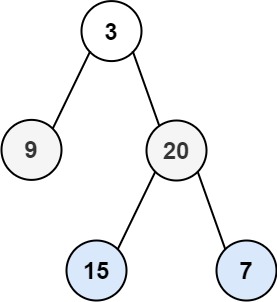Binary Tree Level Order Traversal - Three methods - Two DFS + One BFS
Problem Statement:
Given the root of a binary tree, return the level order traversal of its nodes' values. (i.e., from left to right, level by level).
Example 1:

Input: root = [3,9,20,null,null,15,7] Output: [[3],[9,20],[15,7]]
Example 2:
Input: root = [1] Output: [[1]]
Example 3:
Input: root = [] Output: []
Constraints:
- The number of nodes in the tree is in the range
[0, 2000]. -1000 <= Node.val <= 1000
Solution:
Method 1 is to get height of tree, then for each number less than tree height, traverse the tree and get all keys at that level using DFS.
class Solution {
public:
int height(TreeNode *root)
{
if (!root) return 0;
return 1 + max(height(root->left), height(root->right));
}
void dfs(TreeNode *root, vector<int>&levelVals, int h)
{
if (!root || h<0) return;
if (h==0) levelVals.push_back(root->val);
dfs(root->left, levelVals, h-1);
dfs(root->right, levelVals, h-1);
}
vector<vector<int>> levelOrder(TreeNode* root) {
int H = height(root);
vector<vector<int>> res;
for (int h=0; h<H; h++)
{
vector<int> levelVals;
dfs(root, levelVals, h);
res.push_back(levelVals);
}
return res;
}
};
Method 2 is to do DFS without getting height. Use the logic that if while going down from top, we are at same level as the size of keys array we append a new array and store keys of lower level in new array.
class Solution {
public:
void dfs(TreeNode *root, vector<vector<int>>&res, int level)
{
if (!root) return;
if (res.size()==level) res.push_back({});
res[level].push_back(root->val);
dfs(root->left, res, level+1);
dfs(root->right, res, level+1);
}
vector<vector<int>> levelOrder(TreeNode* root) {
vector<vector<int>> res;
dfs(root, res, 0);
return res;
}
};
BFS Solution: Here we will need a queue. The children of the level nodes are stored in queue. Then one by one we go over the queue.
class Solution {
public:
vector<vector<int>> levelOrder(TreeNode* root)
{
if (!root) return {};
vector<vector<int>>res;
queue<TreeNode *> Q;
Q.push(root);
while (!Q.empty())
{
vector<int> levelVals;
// We cant go from 0 to Q.size() because Q.size() changes inside for loop
// Hence we initialize i once using Q.size() and iterate in reverse.
for (int i=Q.size()-1; i>=0; i--)
{
TreeNode *node = Q.front();
Q.pop();
levelVals.push_back(node->val);
if (node->left) Q.push(node->left);
if (node->right) Q.push(node->right);
}
res.push_back(levelVals);
}
return res;
}
};